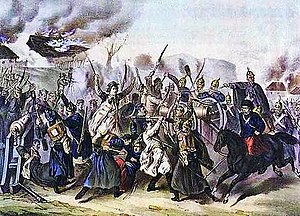Battle of Węgrów
| Battle of Węgrów | |||||||
|---|---|---|---|---|---|---|---|
| Part of January Uprising | |||||||
 | |||||||
| |||||||
| Belligerents | |||||||
|
|
| ||||||
| Commanders and leaders | |||||||
|
Władysław Jabłonowski Jan Matliński | Colonel Georgij Papaafanasopulo | ||||||
| Strength | |||||||
| 2 000 infantry including scythemen |
3 companies of infantry, 3 squadrons of cavalry, 6 cannons | ||||||
| Casualties and losses | |||||||
| 150 | ? | ||||||
Battle of Węgrów was one of the most important skirmishes of January Uprising in the Russian Partition of Poland. It took place February 3, 1863 near Węgrów in east Masovia. On January 22, Polish partisans liberated a town from Russians forces. Here Poles established a military base, in a few days gathering almost 3,500 soldiers.[1]
But the Russians decided to recapture Węgrów by rapid attack force composed of a 1,000-strong unit with artillery, led by colonel Georgi Papaafanasopulo. The Poles were threatened by encirclement, and Polish commander Jan Matliński ordered a retreat from the town. He left about 500 scythemen to cover the retreat of the main forces. Scythemen attacked the Russian left flank and routed Russian cavalry squadron and cannons, ensuring the safe retreat of the Polish forces from the town. Almost all attacking scythemen were killed by Russian infantry fire. Russians entered the town, but most of the Polish forces had already left it.
The Polish attack was heard of throughout Europe. French poet Henri Auguste Barbier wrote a poem Attack at Węgrów, comparing the Polish fighters to Spartans at the Battle of Thermopylae. The Polish poet Cyprian Kamil Norwid, writing in France, also compared the battle to Thermopylae. Maria Konopnicka also wrote a poem about the event, in which she referenced Barbier's work. As a result, the battle is sometimes called the "Polish Thermopylae."
Notes and references
- ^ Eligiusz Kozłowski, Mieczysław Wrzosek, Historia oręża polskiego (The History of Polish Military), vol II. 1795-1939; Państwowe Wydawnictwo Wiedza Powszechna, Warszawa 1984, ISBN 8321403395, pp.333–.
![]() Polish Wikisource has original text related to this article: Bój pod Węgrowem
Polish Wikisource has original text related to this article: Bój pod Węgrowem



